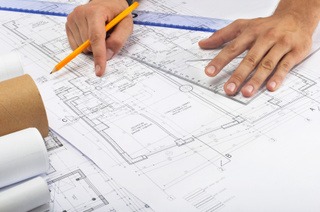What Drafters Do
Drafters use software to convert the designs of architects and engineers into technical drawings. Most workers specialize in architectural, civil, electrical, or mechanical drafting and use technical drawings to help design everything from microchips to skyscrapers.
Duties of Drafters
Drafters typically do the following:
· Design plans using computer-aided design (CAD) software
· Work from rough sketches and specifications created by engineers and architects
· Design products with engineering and manufacturing techniques
· Add details to architectural plans from their knowledge of building techniques
· Specify dimensions, materials, and procedures for new products
· Work under the supervision of engineers or architects
Many drafters are referred to as CAD operators. Using CAD systems, drafters create and store technical drawings digitally. These drawings contain information on how to build a structure or machine, the dimensions of the project, and what materials are needed to complete the project.
Drafters work with CAD so they can create schematics that can be viewed, printed, or programmed directly into building information modeling (BIM) systems. These systems allow drafters, architects, construction managers, and engineers to create and collaborate on digital models of physical buildings and machines. Through three-dimensional rendering, BIM software allows designers and engineers to see how different elements in their projects work together.
The following are examples of types of drafters:
Architectural drafters draw architectural and structural features of buildings for construction projects. These workers may specialize in a type of building, such as residential or commercial. They may also specialize by the materials used, such as steel, wood, or reinforced concrete.
Civil drafters prepare topographical maps used in construction and civil engineering projects, such as highways, bridges, and flood-control projects.
Electrical drafters prepare wiring diagrams that construction workers use to install and repair electrical equipment and wiring in power plants, electrical distribution systems, and residential and commercial buildings.
Electronics drafters produce wiring diagrams, assembly diagrams for circuit boards, and layout drawings used in manufacturing and in installing and repairing electronic devices and components.
Mechanical drafters prepare layouts that show the details for a wide variety of machinery and mechanical tools and devices, such as medical equipment. These layouts indicate dimensions, fastening methods, and other requirements needed for assembly. Mechanical drafters sometimes create production molds.
Work Environment for Drafters
Drafters hold about 207,700 jobs. Employment in the detailed occupations that make up drafters was distributed as follows:
| Architectural and civil drafters | 99,600 |
| Mechanical drafters | 64,800 |
| Electrical and electronics drafters | 27,400 |
| Drafters, all other | 15,900 |
The largest employers of drafters were as follows:
| Architectural, engineering, and related services | 49% |
| Manufacturing | 25 |
| Construction | 9 |
| Administrative and support and waste management and remediation services | 4 |
| Wholesale trade | 2 |
Although drafters spend much of their time working on computers in an office, some may visit jobsites to collaborate with architects and engineers.
Drafter Work Schedules
Most drafters work full time.
How to Become a Drafter
Drafters typically need specialized training, which can be accomplished through a technical program that leads to a certificate or an associate’s degree in drafting.
Education for Drafters
Drafters generally need to complete postsecondary education in drafting. This is typically done through a 2-year associate’s degree from a technical institute or community college.
Technical institutes offer instruction in design fundamentals, sketching, and computer-aided design (CAD) software and award certificates or diplomas upon completion. Programs vary in length but are generally 2 years of full-time education. The types of courses offered will also vary by institution. Some institutions may specialize in only one type of drafting, such as mechanical or architectural drafting.
Community colleges offer programs similar to those in technical institutes that lead to an associate of applied science in drafting or related degree. After completing an associate’s degree program, graduates may get jobs as drafters or continue their education in a related field at a 4-year college. Most 4-year colleges do not offer training in drafting, but they do offer classes in engineering, architecture, and mathematics.
To prepare for postsecondary education, high school students may find it useful to take courses in mathematics, science, computer technology, design, computer graphics, and where available, drafting.
Licenses, Certifications, and Registrations for Drafters
The American Design Drafting Association (ADDA) offers certification for drafters. Although not mandatory, certification demonstrates competence and knowledge of nationally recognized practices. Certifications are offered for several specialties, including architectural, civil, and mechanical drafting.
Important Qualities for Drafters
Creativity. Drafters must be able to turn plans and ideas into technical drawings that will guide the creation of real buildings, tools, and systems.
Detail oriented. Drafters must pay close attention to details so that the plans they convert are technically accurate according to the outlined specifications.
Interpersonal skills. Drafters work closely with architects, engineers, and other designers to make sure that final plans are accurate. This requires the ability to communicate effectively and work well with others.
Math skills. Drafters work on technical drawings. They may be required to solve mathematical calculations involving factors such as angles, weights, and costs.
Technical skills. Drafters in all specialties must be able to use computer software, such as CAD, and work with database tools, such as building information modeling (BIM).
Time-management skills. Drafters often work under strict deadlines. As a result, they must work efficiently to produce the required output according to set schedules.
Drafter Salaries
The median annual wage for drafters is $53,480. The median wage is the wage at which half the workers in an occupation earned more than that amount and half earned less. The lowest 10 percent earned less than $33,910, and the highest 10 percent earned more than $83,300.
Median annual wages for drafters are as follows:
| Electrical and electronics drafters | $59,970 |
| Mechanical drafters | 54,480 |
| Architectural and civil drafters | 51,640 |
| Drafters, all other | 50,470 |
The median annual wages for drafters in the top industries in which they work are as follows:
| Administrative and support and waste management and remediation services | $57,080 |
| Construction | 53,730 |
| Manufacturing | 53,010 |
| Wholesale trade | 52,890 |
| Architectural, engineering, and related services | 52,850 |
Most drafters work full time.
Job Outlook for Drafters
Overall employment of drafters is projected to grow 7 percent over the next ten years. Employment growth will vary by specialty.
Growth in the engineering services and construction industries is expected to account for most new jobs for drafters. However, computer-aided design (CAD) and building information modeling (BIM) technologies allow engineers and architects to perform many tasks that used to be done by drafters, which is expected to temper demand for all drafters.
Job Prospects for Drafters
Overall competition for jobs is expected to be strong.
Specifically, architectural and civil drafters may experience more competition for jobs than mechanical or electrical drafters because of the relatively high number of students graduating in those drafting specialties. Typically, the number of graduates in architectural and civil programs greatly exceeds the number of available positions.
Demand for particular drafting specialties varies across the country because jobs depend on the needs of local industries. Job prospects for mechanical drafters should be best in large manufacturing hubs.
Because many drafting jobs are in construction and manufacturing, job opportunities for drafters will be sensitive to fluctuations in the overall economy.
Candidates proficient in CAD and BIM are likely to have better job opportunities.
| Employment projections data for Drafters, 2016-26 | ||||
| Occupational Title | Employment, 2016 | Projected Employment, 2026 | Change, 2016-26 | |
| Percent | Numeric | |||
| Drafters | 207,700 | 222,200 | 7 | 14,500 |



